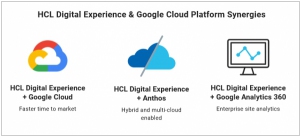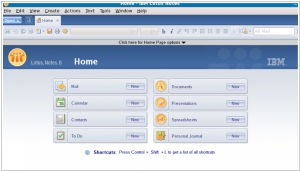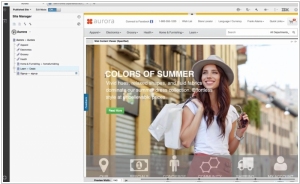HCL Digital Experience is #21 in Top 10 Enterprise Portals
Create an intranet with authenticated access to core applications to improve employee productivity and training and help them get their work done. Help customers get secure, personalized access to their accounts and self-service options, and reduce service costs. Improve the secure exchange of information and applications with suppliers and partners.
Positions in ratings
#21 in Top 10 Enterprise Portals
Alternatives
The best alternatives to HCL Digital Experience are: Liferay, SharePoint
Latest news about HCL Digital Experience
2021. Google and HCL team up for Digital Experience platform

The HCL Digital Experience (DX) platform is now available on Google Cloud, offering clients access to the comprehensive solutions provided by Google Cloud, whether they choose to run their applications on-premises or on other cloud platforms. With this integration, HCL Digital Experience customers can continue leveraging the trusted and reliable features of HCL's Digital Experience platform, while also harnessing the global scalability, security, and flexibility offered by Google Cloud. Furthermore, HCL DX customers will have valuable insights into their customers' interactions with their website, thanks to seamless integration with Google Analytics 360 and HCL Unica Discover. This integration empowers businesses to optimize their customer journeys and enhance overall digital experiences.
2018. IBM sold Lotus Notes/Domino, Websphere Portal and other software to HCL

IBM is in the process of selling its renowned enterprise collaboration software, Lotus Notes, to the Indian company HCL for $1.8 billion. These products have been a significant component of IBM's enterprise business for a considerable period. However, last year, IBM began divesting the development segment to HCL while retaining control over sales and marketing. With the platform's development now outside of IBM's purview and the need for funds after a $34 billion expenditure on Red Hat, it appears that IBM decided it was no longer viable to retain any part of Lotus Notes in-house. On the other hand, HCL recognizes an opportunity to further develop the Notes/Domino business and is seizing it through this acquisition. HCL's interest in Notes/Domino surpasses what IBM has shown over the past decade, as they are heavily investing in rejuvenating the brand. Notes and Domino still maintain a presence in various enterprise sectors, particularly in EMEA (Europe, Middle East, and Africa). This strategic move aligns with IBM's shift towards advancing its cloud business in a different direction. The acquisition of Red Hat in October, in particular, demonstrates IBM's focus on embracing private and hybrid cloud deployments, whereas older software like Lotus Notes and Domino have limited relevance in this new realm.
2008. IBM-Microsoft shoot-out at the Enterprise 2.0 Conference
During the Enterprise 2.0 conference, we witnessed a series of semi-structured Social Software demonstrations that pitted IBM's Connections against Microsoft's SharePoint, moderated by Mike Gotta from the Burton Group. Interestingly, both vendors emphasized the portal aspect: IBM incorporated WebSphere Portal Server, partly to integrate its separate collaboration tool, Quickr, while Microsoft showcased various third-party Web Parts to compensate for the lack of native Social Networking services in SharePoint. IBM appeared more impressive for several reasons. They had a more focused demo team, which should not be underestimated, and Connections featured sleek Ajax interfaces, unlike SharePoint. Although Ajax does not automatically guarantee better usability, when implemented effectively, it simplifies complex interfaces. Social Software tools often come with intricate, power-user interfaces that have overwhelmed enterprise portal users for years. Social Software vendors assume that all users are information enthusiasts who want to navigate multi-column pages filled with small text and numerous links to related, popular, or recommended content. However, many colleagues may not share this preference. One participant questioned whether there were documented best practices to implement Lotus Connections without overwhelming the community. IBM also offered a sneak peek of upcoming alphaware, including a social network analysis module and feed reader, set to enter the market later in the year. In contrast, SharePoint came across as rather dull, and in the chat room, a lone Microsoft representative faced criticism from attendees. There is a discernible anti-Microsoft sentiment among consultants at the conference, which is expected at a "cool" event, but it might also stem from some resentment. Many enterprise attendees I spoke to mentioned that they were experimenting with SharePoint before exploring other tool options in the market. Despite its flaws as a Social Software platform, SharePoint is perceived as straightforward. While IBM's Connections product showcased its strengths, our upcoming Enterprise Social Software Report 2008 will highlight the significant infrastructure requirements it entails.
2006. Mainsoft brings .Net to WebSphere Portal
Mainsoft released new software on Wednesday that aims to bridge the gap between .Net and Java applications running on IBM's WebSphere Portal server. Due to the different programming languages used, integrating applications created with Microsoft's .Net tools and Java programs has been a challenge. However, with Visual MainWin for J2EE, Portal Edition, developers now have the ability to recompile existing Microsoft ASP.Net Web applications, enabling them to run seamlessly on IBM's WebSphere Portal. This integration of Java portal and .Net programs on a single server, supported by IBM, enhances application performance for end users, according to Jenna Dobkin, Mainsoft's director of marketing. Additionally, Mainsoft's solution leverages Novell's open-source Mono software to ensure compatibility between .Net applications and Java portals.
2005. IBM tunes high-end WebSphere server
IBM announced on Thursday that it will release a new version of its WebSphere application server called WebSphere Extended Deployment version 6 at the end of August. This high-end application server is built with utility computing-style features, allowing it to efficiently run multiple applications by automatically distributing computing workloads across multiple hardware servers. The latest edition offers improved tools for job prioritization, supports transaction-intensive and batch workloads, and can run non-WebSphere programs. It also enables software updates without disrupting applications and enhances performance through improved data caching.
2005. IBM beefs up WebSphere for integration
IBM has announced its plans to enhance the standards-based integration tools in the upcoming version of its WebSphere server software, catering to the consistent and high demand from corporate customers seeking effective software solutions to connect diverse systems. According to Robert LeBlanc, the general manager of IBM's application and integration middleware division, the forthcoming release of WebSphere will include support for the latest Web services communication protocols and will further build upon the recently introduced machine-to-machine messaging software. In addition, IBM is exploring the development of specialized versions of WebSphere to target specific purposes. Already, the company has a WebSphere application server specifically designed for radio frequency identification (RFID) applications, as well as a "pervasive" edition that delivers data to embedded and handheld computing devices.
2004. IBM tightens up WebSphere
IBM is set to unveil the features of the upcoming release of its WebSphere application server, focusing on performance and administration improvements. WebSphere Application Server 6, IBM's Java-based server software for business applications, will be launched before the end of the year with enhancements aimed at reliability and ease of management. This update will also showcase IBM's efforts to enhance its standards-based integration software, including a redesigned messaging engine and tools for simplified application integration. Competitors in the Java application server market, such as BEA Systems and Oracle, are also making strides to strengthen their offerings. IBM's WebSphere 6 Application Server incorporates features driven by the needs of independent software vendors and introduces tools for cluster configuration and improved transaction processing. It also supports industry standards like WS-I Basic Profile, WS-Security, and WS Transactions. Alongside the server release, IBM will rebrand its Java development tools for streamlined development tasks. Pricing details for the new version have not yet been disclosed.
2004. IBM expands WebSphere's portal tools
IBM has unveiled a range of enhancements for WebSphere Portal Application Integrator (WPAI), a suite of tools designed to facilitate the development of corporate web applications. WPAI is part of IBM's WebSphere product family, enabling the creation of customized interfaces for workers to access corporate data through internal web portals. The updated tools aim to simplify the process of building applications that display and utilize data from backend systems like human resources databases. WPAI offers an expanded selection of "portlets," pre-built applications for common portal tasks, which can be used as-is or customized to suit specific needs. The objective is to enable seamless integration of various business processes and applications into a portal environment, including self-service human resources portals. In addition, WebSphere Portal now includes enhanced document functions such as importing, exporting, and lightweight editing within the portal, along with portlets that integrate with Lotus collaboration tools for document management. The overall goal is to support different collaboration scenarios, ranging from spontaneous document editing to more complex team sessions, making collaboration more convenient and efficient for users.
2004. IBM readies new WebSphere
IBM has released a developer edition of its WebSphere Java server software, offering a preview of the upcoming major update. The "technical preview" is available as a free download to allow developers and software providers to explore the new features. The final version of WebSphere Application Server Technology for Developers version 6 is expected to be released in the second half of the year. The significant addition to this edition is the support for Java 2 Enterprise Edition (J2EE) version 1.4 standard, which simplifies the creation of web services applications using Java. IBM's WebSphere 6 is initially designed as a simple, low-end version, with more advanced features to be included in subsequent editions. The release is compliant with the interoperability guidelines set by the Web Services Interoperability (WS-I) group, ensuring compatibility with services written in other languages. The new features, including support for Java Connector Architecture (JCA), aim to facilitate integration and enable independent software vendors (ISVs) to connect their applications to existing systems more easily.
2003. IBM eyes modular WebSphere
IBM has unveiled an enhanced version of its WebSphere Java server product line, aiming to enhance the integration of components within its software portfolio. The company is developing a "modular architecture" for the WebSphere Java application server, enabling customers to seamlessly combine IBM software products with WebSphere. This architecture will make its debut as part of an upcoming product, currently referred to as Vela and expected to be named WebSphere 6, slated for release in the latter half of the following year, as confirmed by an IBM representative. The WebSphere application server is utilized for running custom business applications. IBM's Software Group has long pursued the objective of establishing a more modular software architecture across its entire product line. To achieve this, the company is adopting Java and Web services standards as the unified foundation and binding element for its interconnected products.
2003. IBM readies WebSphere Portal update
IBM has announced that version 5 of its WebSphere Portal software will be released on August 21. The updated portal software from IBM offers various enhancements to facilitate document sharing and storage among workers. It includes applications for creating text documents, spreadsheets, and presentations. The update also brings improvements to the searching capabilities and streamlines the installation process. The pricing for WebSphere Portal is set at $87,000 per processor. Additionally, IBM offers WebSphere Portal Express, specifically designed for small and medium-sized businesses, starting at $85 per user or $33,000 per processor.
2003. IBM updates WebSphere wares
IBM is expanding its software and services offerings to help companies enhance the usability of wireless mobile devices in the workplace. The company is introducing its Mobile Office Entry Jumpstart Solution (MOEJS), which assists businesses in piloting hardware, software, and services for mobile devices. IBM's Global Services division is currently selling the package in the United States. With MOEJS, IBM supports operating systems used in 90% of the handheld market, including Linux, Palm, Symbian, and Pocket PC. The solution allows companies to start small with basic email capabilities on wireless devices and then gradually incorporate new applications supported by other WebSphere software. Components of MOEJS enable push notifications for important information, alerts from supply chain and legacy systems, and seamless roaming between cellular networks and wireless local area networks. The package, which includes server software, devices, and wireless cards, starts at approximately $80,000 for 25 clients.


